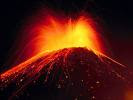Volcanic eruptions can be destructive and also creative.
We can usually predict when a volcano is about to erupt as the sides of the volcano bulge outwards. Earthquakes are also quite likely to happen before a volcano erupts. There are also gaseous fumes which smell really bad.
The magma builds up in the chimney of the volcano and mixes with the gases from the melted rocks. This mixture then rises to the top of the chimney and explodes out of the cone.
Dust, steam, gas and hot rocks explode out of the cone. These hot rocks are also known as volcanic bombs. These can be the size of a house and be hurled miles away from the volcano, though there can also be smaller fragments which are hurled even further and be just as destructive.
Lava (hot molten rock in liquid form) flows out of the chimney. The thicker the lava, the slower it flows and doesn't usually travel far and forms large rocks when it cools. The lighter the lava the faster and further it flows. Lava incinerates anything in it's path.
Volcanoes also release gases such as hydrogen and carbon dioxide. When hydrogen and oxygen mix, they form water vapour which contributes to the water cycle. Carbon dioxide is used by plants to make food.
The dust and ash released from volcanoes can act as fertilizer for the soil surrounding the volcano area.
We can usually predict when a volcano is about to erupt as the sides of the volcano bulge outwards. Earthquakes are also quite likely to happen before a volcano erupts. There are also gaseous fumes which smell really bad.
The magma builds up in the chimney of the volcano and mixes with the gases from the melted rocks. This mixture then rises to the top of the chimney and explodes out of the cone.
Dust, steam, gas and hot rocks explode out of the cone. These hot rocks are also known as volcanic bombs. These can be the size of a house and be hurled miles away from the volcano, though there can also be smaller fragments which are hurled even further and be just as destructive.
Lava (hot molten rock in liquid form) flows out of the chimney. The thicker the lava, the slower it flows and doesn't usually travel far and forms large rocks when it cools. The lighter the lava the faster and further it flows. Lava incinerates anything in it's path.
Volcanoes also release gases such as hydrogen and carbon dioxide. When hydrogen and oxygen mix, they form water vapour which contributes to the water cycle. Carbon dioxide is used by plants to make food.
The dust and ash released from volcanoes can act as fertilizer for the soil surrounding the volcano area.
WATCH BELOW
Video Source: http://youtube.com/watch?v=CgpNqrR318U

3 comments:
Hello
robbbbbbbeeeeerrrrttttt
Yeh!!! Hence!!!
Post a Comment